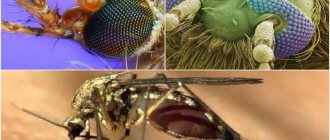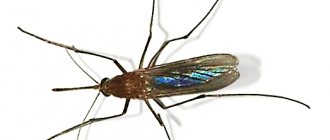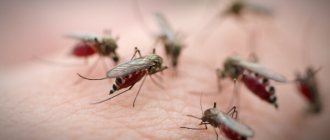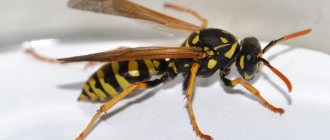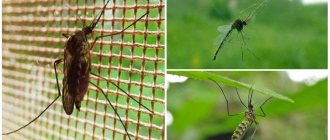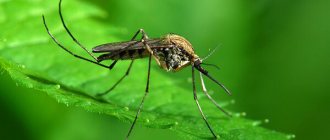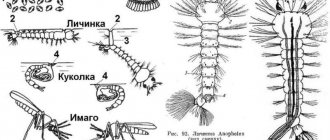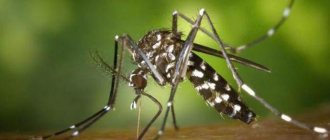Mosquito insect: types, brief description, photo
There are several types of mosquitoes, the most common of which are the following:
- Squeaker. This species is the most numerous. Its peculiarity is that it inhabits almost all corners of the planet. The squeak is small in size, females feed on blood, while males are content with plant food.
- Centipede. The peculiarity of this insect is its size; a mosquito can reach 6-7 cm in length. At the same time, long-legged mosquitoes are absolutely safe for humans and their health.
Mosquitoes
- Tropical mosquito species. This type of insect is distinguished by the fact that it poses a danger not only to health, but also to human life. It is these mosquitoes that carry the most terrible diseases.
- Dergun. The insect got its name because of the constantly twitching long legs that the mosquito puts aside while sitting on any surface. For people, as well as other animals, these representatives of the animal world are harmless.
The common mosquito: where and how long does it live, what does it feed on in the forest, in the swamp?
This insect can also be found under the name “squeak mosquito”. If we talk about the scale on which these bloodsuckers are found, they are truly surprising.
- Squeakers are found throughout Europe. You can also find them in more remote areas of the Earth; they got there during the time of the Great Geographical Discoveries.
- If we talk about the terrain that peepers prefer, it is most often swamps and forests. Bloodsuckers choose this place for a reason, because they love humidity and warmth. It should also be noted that the common mosquito can live anywhere, provided that its food source, that is, a person, is nearby.
Common mosquito
- Regarding the nutrition of these insects, it must be said that only females drink blood, since it is this type of food that they need for procreation. Males prefer plant juices - this is their only food. The females of this insect, both in the forest and in the swamp, in the absence of humans, look for another source of blood. Often the source is other animals: frogs, birds, etc.
- The life of a mosquito is full of various challenges. Its lifespan depends on the environment and temperature at which the bloodsucker is located. It is important to say right away that females live 1.5-2 times longer than males. Generally speaking, females can live from 40 to 120 days, males are correspondingly 2 times less.
How to distinguish a female mosquito from a male: comparison, photo
Almost all animals of the same species differ from each other in the structural features of their bodies, depending on whether they are females or males, and mosquitoes are no exception.
- Mosquitoes have what are called “antennas”. So the main difference lies precisely in them. Males boast lush, thick antennae that resemble whiskers. They need them to hear better. The female does not have such beauty; her antennae are much smaller and practically invisible to the naked eye. In principle, she does not need them, since she does not need hearing, because she is not looking for a partner, but the partner is looking for her.
Female and male
- But the female has a well-developed oral apparatus, with the help of which she can bite the victim and thus provide herself with blood. The male has no need for this - he feeds exclusively on plant foods.
- Also, female squeakers have more developed sensory abilities. They need them to find a donor. As is already clear, male mosquitoes do not possess these abilities, since they do not need donors.
Let us conclude that the structure of the oral apparatus of a mosquito and a mosquito is different. This is due to the fact that the female needs to receive blood for reproduction, and for this she needs to initially bite the victim in order to bite through its skin. The male feeds exclusively on plant foods – plant juice, nectar of different flowers. Its oral apparatus is developed in such a way that it simply has no teeth. Therefore, only mosquitoes bite these insects.
Do they bite or not?
The most important questions that haunt many adults and children: do large mosquitoes bite people and what will happen if a large mosquito bites? The fear of this insect is completely justified; seeing a mosquito of such impressive size is difficult to remain calm. However, there is no need to worry, the ballerina does not have piercing bristles, which can be used to pierce the skin. Therefore, the centipede simply physically cannot drink human blood.
The caramora can feed on the nectar of plants thanks to its long proboscis. There are a sufficient number of insects that have absolutely no need for a food source. After emerging from the chrysalis state, the ballerina's main task is to reproduce and lay eggs.
Does a mosquito have a brain, a heart, what organs are there, how many teeth, what does a mosquito squeak, and does it breathe?
Mosquitoes, like any other living creatures, have a certain body structure and internal organs.
- Bloodsuckers have a heart, it is represented by a muscular tube. The blood of these insects is colorless.
- Regarding the brain, it must be said that it also exists. It is represented in mosquitoes by the suprapharyngeal ganglia. They are divided into 3 parts and form the forebrain, midbrain and hindbrain. Each part of the brain performs its own functions.
- Many people wonder whether bloodsuckers have teeth. Mosquitoes have teeth, moreover, they play an incredibly important role in the life of this insect. After all, it is with the help of teeth that a mosquito bites through the donor’s skin. However, they have an unusual appearance for us - prickly bristles. An adult mosquito can have about 50 of them.
Structure of a mosquito
- The insect makes a squeak using nothing other than its wings. Due to the frequent flapping of thin wings, such a sound is formed that is unpleasant to our ears.
- Unlike people, all insects breathe using the trachea, and not the lungs, since they simply do not have the latter. The tracheas of bloodsuckers are represented by tubes through which air passes and which come out on the sides of the body with peculiar openings - spiracles.
- Generally speaking, these insects have a nervous system, oral apparatus, excretory organs, a heart and, accordingly, a circulatory system, genitals, and a respiratory system.
Miracles of body structure
It is difficult to determine the exact mass of a mosquito, since its value is largely determined by the amount of food eaten. But there are still averages:
- a hungry insect weighs no more than 2 mg;
- Well-fed weight can reach from 3 to 5 mg.
Mosquito legs - what's special?
Many people are interested in the question of how many legs a mosquito has. He has three pairs of legs, like most insects on our planet. Each tarsus consists of five segments, and the last one necessarily has suckers, which are developed differently in each specific species.
However, it is not the number of legs that is of interest, but those very suction cups that allow the mosquito to calmly hold its body on vertical surfaces.
Oral apparatus
The mouthparts of a mosquito are no less interesting. It consists of two pairs of jaws and two lips - upper and lower. The lips of this insect are slightly elongated and, having such a structure, resemble a gutter. If you look inside it, you can find long needles that are jaws.
So, these insects have jaws, lips and even a tongue that produces saliva. And here a reasonable question arises: do mosquitoes have teeth? And what’s surprising is that there is. They are very small, and their number reaches 50 pieces. It is thanks to them that the bloodsucker can pierce the skin.
What are wings - the ability to fly or... sing?
Another amazing feature of these insects is the ability to squeak in the absence of a voice. So, why does a mosquito squeak? In fact, the squeak is not the result of the vocal cords, but the sound it makes with its wings.
On a note! Other insects are also capable of producing characteristic sounds using only their wings. And most of them make a buzzing sound - flies, bees, bumblebees, wasps, etc.!
Why doesn’t a mosquito buzz, but rather squeak? It's all about size. His wings, like himself, are very small and also quite thin and narrow. Each wing beat merges with the sound of the next beat, generating a high-frequency sound that our ear perceives as a squeak. How many flaps per second does a mosquito make? Their frequency is incredibly high and amounts to about 600 times per second!
Some interesting facts about mosquito squeaks:
- this sound helps females attract males during mating;
- mosquitoes hear not a squeak, but vibrations of sound that they pick up with their antennae;
- in females the squeak is somewhat thinner than in males;
- The squeak of young females differs from the sound of adults, and it is precisely based on these differences that the male chooses a mate for himself - a more mature female.
How does a mosquito sleep in the summer, where does it hibernate, and at what temperature does it die?
The activity of a mosquito directly depends on the air temperature where the insect is located. When the temperature drops significantly, for example, at the beginning of autumn, the bloodsuckers disappear, since such a temperature is not suitable for them to reproduce.
- Insects overwinter where they live. Mosquitoes do not fly to another area, country, etc.
- Gaps, cracks in walls, secluded corners, windows, curtains - all these are ideal places for mosquitoes to hibernate.
- Mosquitoes do not disdain various non-residential buildings, such as sheds, garages, etc.
- It is important to note the fact that, in principle, mosquitoes do not need to sleep. If environmental conditions are suitable for it, it will actively continue its activities, reproduce and live.
Optimum temperature for mosquitoes +15-20°C
- High temperatures are more destructive for these insects. The higher the air temperature, the shorter the mosquito's life will be. As for low temperatures, bloodsuckers hibernate at above-zero temperatures, however, if the climate changes slightly and becomes colder, mosquitoes will simply go into their other state - torpor.
- The optimal temperature for the life of these insects is considered to be +15-20°C. It is difficult to say unambiguously what mark on the thermometer will indicate that mosquitoes will die at this temperature. However, temperatures of -7°C and above 28-30°C will have a negative effect on mosquitoes, as a result of which they may die.
Where do mosquitoes come from, how are they born and reproduce?
Initially, during the mating period, males look for their females. The thing is that mosquitoes make a squeaking sound with their wings, it differs from the sound that males make. Moreover, the males of these insects are very selective, since they prefer older females. They also determine the age of a female by the sound her wings make when flying.
- Next, the insects form a kind of swarm, and at this time the fertilization process itself occurs.
- After this, the mosquito begins to actively search for food, however, at this time it is exclusively interested in blood. Having received the required portion of food, the insect lays eggs.
- Larvae emerge from the laid eggs.
Life cycle of a mosquito
- After a certain time, pupae are formed from such larvae.
- In this state, the future insect continues to develop for some time. In just a couple of days, each pupa will mature into a fully viable insect - a mosquito.
Mosquito larvae: what do they look like, what are they called?
Most often, mosquito larvae are called simply larvae, however, sometimes you can find another name - “bloodworm”. By bloodworm we mean the general name for the larvae of these insects, however, it may differ depending on the type of mosquito, etc.
- Bloodsucker larvae, as is already known, emerge from eggs laid by an adult.
- As a rule, mosquitoes lay eggs in damp places, in ponds, and containers with standing water. Accordingly, the larvae live in the same places.
The larva turns into a pupa
- Outwardly, the larva resembles only a small fish or a small worm that has been born.
Description of the immature individual
The life cycle of a mosquito includes several stages - egg, larva, pupa, adult. At the larval stage, the appearance is significantly different, as is the habitat.
The female lays eggs in a body of standing water or damp soil. Within a few hours the larva appears. Body size does not exceed 2 mm. Outwardly it looks like a gray worm. The entire development cycle is 8-30 days. Directly depends on temperature conditions. During this time, 4 moults occur, after each immature mosquito increases in size to 10 mm.
An immature mosquito consists of a head, chest, and abdomen. However, visually it is a single whole. The surface is covered with small fibers. Breathing is cutaneous-gill, so periodically the larva dives under water to a depth of 1 m. It feeds on protozoa and passes through itself up to 1 liter of water per day. The inside is primitive, no brains, no heart.
On the head there are 2 simple eyes and complex, small antennae. Vision is poorly developed. The mouthparts do not have a spiny combination; they simply swallow food. The abdomen consists of 8 segments and looks like a tail.
The development of the larva ends with pupation. The extremely mobile pupa has the shape of a comma and lives in the water column. Complex processes take place inside, and after a few days the shell breaks. Initially, the head, chest, abdomen, then limbs are shown. This is how an adult mosquito appears.
Interesting!
Males are always born first. They gather in the grass along the pond, waiting for females. For some time, the young generation of both sexes feeds on nectar and leads a carefree lifestyle. After mating, females turn into bloodthirsty individuals. They need protein for the formation of eggs and the reproduction of a healthy generation.
From the eggs laid by the female on the surface of the water, larvae hatch, which intensively feed and grow before pupation.
After leaving the egg and before the stage of maturation, the larva increases in volume by more than five hundred times, and in length by more than eight times.
Increased growth leads to the fact that the larvae undergo periodic molting, that is, they shed their old outer covers and form new, larger ones. During maturation, the larva goes through four larval instars.
Only hatched larvae are about 1 mm in length, after the fourth molt - 8-10 mm. In addition to an increase in size, at each stage there is a complication of the internal organization. After the completion of the fourth stage, the pupa appears.
At this stage, some internal organs are rebuilt, which leads to the formation of adult mosquito organs. The completion of the development of an adult mosquito occurs with the release of the insect from the pupal skin.
Structure of the larva
The larvae of different species emerging from eggs differ from each other in head shape. Those that feed from the surface of reservoirs have elongated and narrow heads. When feeding on plankton or bottom sediments, the larval head will be more developed in width than in length. Carnivores have a special head structure, different from the previous two.
The larvae have eyes on the sides of their heads. The mouth, depending on the type of nutrition, can be scraping or suction type. In predatory species, the mouthparts are adapted for catching and chewing prey. The chest plates are fused together. The abdomen consists of 9 segments.
The digestive tract of the larvae is almost a straight tube. Digestion of food occurs in the middle intestine. The digestive tract is supplemented by a pair of salivary glands and intestinal appendages.
Doll
The developed larva moves to the next stage: pupation. The pupa is lighter than water due to the large number of air chambers. At this time, almost fully formed small mosquitoes are at greatest risk, as they represent helpless food for fish.
The adult insect that hatches from the pupa dries up and sets off to look for a mate for reproduction.
How dangerous are mosquitoes, why is it necessary to fight mosquitoes?
By themselves, as animals, mosquitoes, in principle, are not particularly dangerous, however, these insects are carriers of serious illnesses.
- These bloodsuckers are primarily dangerous because they carry diseases such as malaria. It is important to understand that this disease is transmitted only by malaria mosquitoes.
- Also, bloodsuckers can “give” a person, by biting him, various types of fevers.
- In addition, insects are carriers of encephalitis, a serious disease that is very dangerous not only for health, but also for human life.
- Mosquitoes can also carry some infectious diseases.
An integral link in evolution
Why are annoying mosquitoes needed in nature? What function do they perform? These insects are a source of food for other beetles - dragonflies, swimming beetles, water striders, ticks, spiders, and water bugs. Since they breed in the vicinity of reservoirs, crustaceans, frogs, salamanders, various species of reptiles, and fish like to eat their larvae and adults. Mosquitoes are a source of food for river and sea birds that can stay on the water surface - gulls, terns, wild ducks and geese, phalaropes.
It’s easy to guess what will happen if mosquitoes disappear. The main source of food will disappear from the usual chain of evolutionary development of all the above-listed individuals, which will entail a significant reduction in their number. The disappearance of one link leads to the disappearance of others... So it is necessary to “find a common language” with mosquitoes in order to maintain the natural balance on Planet Earth.
Can mosquitoes carry diseases, HIV, hepatitis C?
Today you can hear information that these insects are capable of transmitting a disease such as hepatitis. Scientists have conducted a number of studies, their results are as follows:
- It is almost impossible to become infected with this particular disease.
- The viruses of this disease “live” in the blood, and when a mosquito bites its victim, it injects it exclusively with its saliva.
- The insect's mouthparts are designed in such a way that blood can only be sucked inwards, after which the bloodsucker cannot throw it out.
- The same situation occurs with HIV. Moreover, this insect simply will not be able to transmit the required amount of virus to a person for infection.
- Regarding other diseases that were described earlier, things are different. Mosquitoes can easily infect the people they bite with them.
What will happen if mosquitoes disappear?
If you think about this issue and try to comprehend it globally, you can come to the conclusion that the complete disappearance of certain species of animals may occur.
- Since mosquitoes are the food of many animals, if they disappear completely, these species will also die out.
- Moreover, these insects will be replaced by others that will multiply even faster and cause even greater harm to nature and humans. For example, various types of midges and ticks.
- We can also say that mosquitoes perform a protective function. It is precisely because these insects have infested the jungles and many forests that this area is not exposed to human influence. The development of these territories by humans will lead to an increase in the population on the planet and, accordingly, to a shortage of all the most important resources.
- In addition to the animal world, the plant world will also suffer, because if these insects are gone, then there will simply be no one to pollinate some flowers and plants.
Mosquitoes are useful!
It would seem, what could be the benefit of mosquitoes? They only fly and bite, while also carrying some diseases. But in fact, these insects are unique creatures of nature, according to the laws of which nothing can happen for nothing.
- Firstly, mosquitoes are food for fish, birds, other large insects, newts and many species of other animals, and therefore represent the stability of the food cycle.
- Secondly, these ubiquitous insects occupy by no means the last place in the ecological balance, since after turning into an adult insect they take important microelements from water bodies and enrich the soil with them after their death.
- Thirdly, males, feeding on nectar, contribute to the pollination of plants by carrying pollen on their paws.
- Fourthly, a mosquito, simply feeding on blood, supplies it with anticoagulants that reduce clotting, and this is useful for people suffering from diseases associated with high platelet levels.
And even if the scientific facts and compelling arguments regarding the benefits of mosquitoes are never discovered, you know enough that such a simple and sometimes annoying mosquito deserves your respect.
Malarial, common mosquito, mosquito: comparison, similarities, differences, photos
Many types of mosquitoes are very similar to each other, which is why we often confuse them.
- Malaria mosquito. This insect has fairly long legs and a proboscis. If we compare these insects with ordinary mosquitoes, they have some differences. The legs of the malarial bloodsucker are much longer, as is its proboscis, compared to the limbs of the squeak.
- Mosquitoes are insects that, in principle, are similar to ordinary mosquitoes, however, they differ from the latter in the environment in which they develop and live. The similarity of these bloodsuckers is that they feed not only on plant foods, but also on blood.
- At the same time, malaria mosquitoes and mosquitoes are dangerous for people, because they carry various ailments and infections. While an ordinary squeak does not pose such a danger.
Types of mosquitoes
Practice includes several dozen species of these interesting insects; within the framework of the material, the most common varieties of different mosquitoes will be considered. This is a mosquito of the species centipede, anopheles, squeak and other individuals. Let's look at what types of mosquitoes there are according to classification, habitat and other characteristics.
Common mosquito (squeaker)
These types of mosquitoes can be found everywhere and are particularly annoying, with females infecting both people and domestic animals and livestock. The squeak mosquito is quite dangerous because its bites cause itching, burning and discomfort. The size characteristics of adult individuals reach parameters of the order of 3-8 mm; only females drink blood, while males feed on food of plant origin, mainly juices. The squeak mosquito can be a carrier of serious diseases; it spreads strains of viruses. Also, the mosquito (male or female) squeaker can carry infectious type eczema. The traditional mosquito of the genus squeaker is found in the middle zone, where a humid climate prevails.
Centipede
Centipede mosquito Karamor
The centipede mosquito is a long-legged mosquito that prefers to live in places with high levels of humidity. It usually settles near shallow bodies of water, in swampy areas, and in thickets of forest. A mosquito of the genus centipede can reach a length of 4 to 8 cm; it is often mistaken for a malarial insect, and this is a misconception. Karamor is the largest mosquito in the world. The centipede does not bite; the diet of the individual is dominated by juices of plant origin, so this insect does not pose a danger to humans. However, the centipede mosquito can cause irreparable damage to agricultural lands. Caramora larvae are especially voracious, preferring plants and algae, as well as the tender roots of newly formed plantings.
Malaria-type mosquitoes
Anopheles mosquito
The Anopheles mosquito acts as a carrier of serious parasites, this applies to many of its species. Most often, the diseases carried by these individuals are malaria and plasmodia. The size indicators of this insect are not much different from an ordinary squeaker, but if you look closely at its appearance, you will notice very long hind legs. As for the antennae, they achieve the same external indicators as the sting. These types of mosquitoes prefer to live in places where there is access to a body of water, since egg laying and larval development occurs exclusively in aquatic environments.
Biting mosquito with two stripes
This is far from the largest mosquito from this family of insects; on the contrary, it is small in size. According to their habitat, individuals can be found on any continent with the exception of Antarctica, where it is always cold. Mosquitoes of this type are found in the tundra and shady forests. The main external distinguishing feature of the individual is the presence of white stripes in the limbs and body. Eggs are laid in late autumn on the banks of swamps; humans rarely appear in this area. Adult mosquitoes carry dangerous diseases, and these mosquitoes kill people.
Winter insects
Compared to other species of individuals, this is a huge mosquito, which has external manifestations along with centipedes and large spiders. But there are enormous differences in terms of the lifestyle of insects. These are not blood-sucking mosquitoes that prefer to live in caves, inside stumps and trees that are half rotten. They feed on plant waste and pose no danger to humans. Adults can reach 20 mm in size. They are found all year round, even in the winter months, which is actually why they got their name.
Meadow mosquito
This species is not a bloodsucker; on the contrary, individuals prefer to eat nectars of plant origin. In size, this is an ordinary mosquito that prefers to lay eggs in water or other moist, damp environment. During the growth stage, the larvae can eat the remains of algae or plant products, and sometimes they can take on the role of predators. Typically, such individuals prefer to settle in flooded meadows and in places where there is an abundance of moss.
Mosquito Dergun
Mosquito Dergun
The individual is harmless, life expectancy is only 2-5 days. Preferred habitats are dense thickets formed on ponds, small rivers or swamps. Individuals that have reached adulthood are usually dark brown in color and have long limbs. They often fly in clouds over bodies of water, but are not capable of harming humans, since they prefer a vegetarian diet.
Tiger mosquito
Asian tiger mosquito
The Asian tiger mosquito is an insect to be wary of. It is native to Asia but has recently been discovered in Europe. The main harm of the insect is that it carries serious viral infectious diseases - malaria, typhoid, Dengue fever, ZIKA virus and other diseases accompanied by serious symptoms. Dengue fever and the Zika virus are a dangerous viral disease. This is a tropical mosquito, so it is found mainly in the wild. This is a small insect with two black and white wings.
A mosquito with long legs: what is it called, does it bite?
These insects, which are huge compared to ordinary mosquitoes, instill fear in almost all people. Are they really dangerous?
- This insect is called a caramora or simply a long-legged mosquito .
- These insects are distributed almost everywhere, with the exception of places where it is constantly very cold.
- Regarding the danger that Karamora can bring, the following must be said: it simply does not exist. This mosquito does not have the necessary structure of the oral cavity to carry out any biting actions.
Long-legged mosquito
- The proboscis, which we can see with the naked eye, only gives the insect the opportunity to feed on plant food, and the length and size of the body are just the characteristics of this mosquito.
mosquito larva
The larva is spindle-shaped and consists of three sections: head, thorax and abdomen. The head is large, wide, movably connected to the chest. The larva feeds on plankton. The movement of water caused by the fan of hairs along the edges of the upper lip brings small organisms into the oral cavity. On the head there are large eyes and long antennae with bristles. The thoracic region is swollen, with long, branched hairs growing on it. The abdomen consists of 10 segments. The last segments of the abdomen merged to form a respiratory siphon. At its end there are stigmas through which the larva breathes atmospheric air. The siphon has a ridge of 12-15 teeth. The squeak mosquito larva swims using a fin on the 9th abdominal segment.
At what altitude do mosquitoes fly, to what floor do they reach?
Sometimes it seems that these squeaking bloodsuckers are simply ubiquitous. Despite the small size of its body, this insect is capable of rising quite high in the air and pestering even residents of high-rise buildings.
- Despite such encounters with mosquitoes, they themselves do not fly too high of their own free will. Mostly these insects rise above the ground only a few meters.
- However, drafts and wind can lift such a small insect much higher than 2-3 m. If we are talking about the presence of these creatures on the upper floors of, for example, a 9-story building, then it is worth saying the following: they get there mainly not through the open air, but through ventilation hatches, etc.
Mosquitoes fly high only when there is wind
- During such flights, the insect rests several times, clinging to surfaces. This is how mosquitoes can reach the highest floors.
- There is information that this insect was found on the 54th floor of the building.
Interesting facts about mosquitoes
Despite the fact that few people like mosquitoes, their lives are full of interesting things. And if we consider these insects not as bloodsuckers, then the interest in them will be much stronger.
- Mosquitoes have a unique daily routine. During the day, these creatures rest, hiding not only from the bright rays of the sun, but also from other animals that feed on them.
- There is information that this is exactly the number of mosquitoes – 1,200,000 – needed to drink all the blood from a person.
- Many people do not know the fact that only female mosquitoes drink blood and bite, however, this is true.
- Initially, mosquitoes were called flies, in principle, like all other dipterous insects.
- Mosquitoes are able to smell prey at a distance of several tens of meters.
As you can see, mosquitoes are not only constantly disturbing squeaking creatures. These insects benefit both humans and all living nature. Moreover, the death of these insects will lead to irreversible processes, so it is impossible to deliberately exterminate them.
Are they dangerous for humans?
Despite the fact that the caramora is completely indifferent to blood, the insect poses a serious problem for agricultural land. The following representatives of the order Diptera insects can cause the greatest harm:
- Marsh Centipede;
- Cabbage caramora;
- Autumn ballerina.
These pests have a detrimental effect on plant crops that love moisture. Caramora larvae can destroy a significant part of the crop sown on wet mineral soil and peat bogs. Ballerina can harm berries, legumes, root crops and cereals. Cultivated pastures located near water are most susceptible to mass attack by caramora larvae.
In the summer, centipede larvae are fought, like all pests, with the help of modern insecticidal agents and fall plowing is done. In summer cottages, the same methods are used to combat ballerina. However, if there is no body of water near your site, there is nothing to worry about; the larvae will not be able to damage the crop.
Now you know how dangerous large mosquitoes are.
